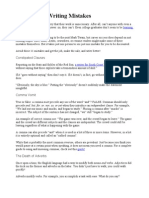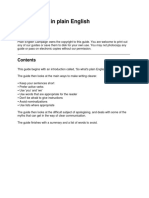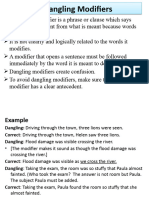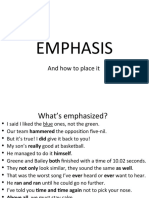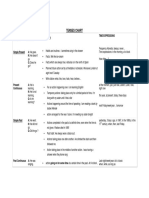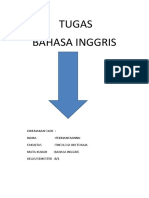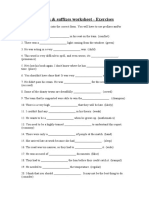2A: SYNTAX AND WORD CHOICE
Syntax: the arrangement of words and phrases to create well-formed sentences
1. Write Complete Sentences
In informal conversation, we often speak in partial sentences, as in the response of Holly below:
Randall: Holly, why were you late for today’s meeting?
Holly: Because of traffic on I-215.
This reply is fine in colloquial speech, but when put in writing, it becomes a sentence fragment.
Sentence fragments don’t belong in business writing.
Watch this video to review the three fundamental parts of a sentence.
Sentence Structure
The video identifies three building blocks: subjects, verbs, and complements. Subjects are the
actors in the sentence; they either “do” or simply “are” something. Verbs describe the action —
what is happening. Complements add meaning to the sentence by completing or further
specifying the actor and the action.
If a collection of words ends in a period but does not contain both a subject and a verb, it is a
sentence fragment. To avoid fragments, make sure that every sentence you write has both a
subject and a verb and can stand alone.
When the subject and verb work together to express an idea, you’ve got a clause. Clauses are
the basic building blocks of sentences. Phrases (which may have nouns, verbs, and other parts
of speech) do not have subjects; nothing is doing the action in a phrase.
Competent writers need to understand the difference between a phrase and a clause, and
between independent and dependent clauses. This video clarifies the differences:
Is it a Phrase or a Clause?
Version 2019.05.09 1
�The video shows examples of phrases and clauses and clarifies that dependent clauses leave
the reader needing more information to complete the idea of the sentence. Independent
clauses can stand alone.
In the next chapter, we’ll examine how phrases and clauses affect punctuation, especially the
placement of commas. For now, we’ll keep Fundamental #1 simple: Never use a phrase or a
dependent clause as a sentence. Make sure all of your sentences contain at least one
independent clause. Otherwise, your writing (and worse, your thinking) might appear
fragmented.
2. Use Strong Subjects
In sentences, subjects are doing the work; they are doing or being something. Every sentence
you write should have a strong subject. In other words, state clearly who or what is doing the
action.
Sounds simple, right? You’d be surprised at how easily weak subjects infiltrate our writing. The
culprit is often one of two bad habits: starting your clause with “there” or “it,” or starting with a
verb that you’ve turned into a noun (a practice known as “nominalization”).
This video shows how to notice and avoid using “there” and “it” as subjects.
Avoid “There” and “It”
“There” and “it” are not always off limits as subjects. Your writing will be stronger, however, if
you try to rewrite a sentence to give it a stronger subject. Consider the following examples:
WEAK: There are many ways a business can go bankrupt.
STRONG: A business can go bankrupt in many ways.
EVEN STRONGER: For a business, many roads can lead to bankruptcy.
Nominalizations can suck the life out of a verb and turn it into a bland, bureaucratic noun. This
next video shows why and how to avoid using nominalizations as subjects:
Avoid Nominalizations
Version 2019.05.09 2
�Not all nominalizations are off limits, of course, but they often weaken sentences—even when
not functioning as subjects. Examine these examples of nominalizations and their alternatives.
Note how getting rid of the nominalizations makes the sentences shorter:
WEAK: Southwest Airlines made a decision to expand its
Along with strong international
subjects, try to use strong routes.
verbs. Where possible, STRONG: Southwest Airlines opted to expand its international
replace weak verbs —be, routes.
have, see, want, etc. --
with more active verbs. WEAK: A new budget airline offers direct competition to
Southwest.
Weak adverbs (such as
STRONG: A new budget airline competes directly with
really, very, or pretty) also
create verbal clutter. Southwest.
Instead of a “weak adverb
Nominalizations are especially damaging when they take the
place of a strong verb. In the first example (Southwest
Airlines . . .), eliminating the nominalization changes the verb from “made” to “opted”—much
stronger.
3. Mind Your Modifiers
Adjectives and adverbs modify (describe) other words. A modifier may be a single word, such as
an adjective (which modifies a noun) or an adverb (which modifies a verb, adjective, or adverb).
A modifier may also be a group of words—a phrase. The following phrases act as adjectives;
they are adjectival phrases:
● Arriving home exhausted
● As the manager
● Compelled to protect her young
Each of these three phrases is written to describe a noun—and the noun that they describe
should be the very next word in the sentence. When you put a different word after an
introductory adjectival phrase, you’re committing an error called either a “misplaced” or a
“dangling” modifier. Here’s an example of a misplaced modifier:
NO: Arriving home exhausted, my toothbrush and my bed were the only things I
Version 2019.05.09 3
� wanted.
(Your toothbrush arrived home exhausted? Really? That’s a misplaced modifier!)
YES: Arriving home exhausted, I wanted only my toothbrush and my bed.
For additional insight on how introductory phrases can easily become misplaced modifiers,
watch this instructional video:
Those Pesky Introductory Phrases!
Dangling modifiers occur when the noun being modified never actually appears in the sentence,
as in the following two examples:
NO: As the manager, the refunds were handled carefully.
(The refunds are the manager? That’s a dangling modifier; the manager is never
identified.)
YES: As the manager, I carefully handled the refunds.
NO: Compelled to protect her young, a camouflaged nest was hidden in the rose bush.
(Another dangling modifier. Who’s protecting whose young?)
YES: Compelled to protect her young, the female robin camouflaged her nest in the
rose bush.
Adverbs also function as modifiers, and the same rule applies when placing them in your
sentences. Keep your adverbs close to the word they modify. This proximity keeps the
meaning clear. Notice how the misplacement of an adverb (underlined in the sentences below)
reduces clarity:
MISPLACED ADVERB: Tony fixed the clog in his bathroom drain skillfully.
(What does the adverb “skillfully” have to do with drains? Isn’t
it modifying the verb “fixed”?)
WELL PLACED ADVERB: Tony skillfully fixed the clog in his bathroom drain.
MISPLACED ADVERB: Our sales manager tried to overcome the client’s objections
doggedly.
(What does “doggedly” have to do with “objections”?)
WELL PLACED ADVERB: Our sales manager doggedly tried to overcome the client’s
objections.
Or, as we learned in the sidebar above, try eliminating the adverb altogether by using a
stronger verb:
Version 2019.05.09 4
� ADVERB NO LONGER NEEDED: Our sales manager strived to overcome the client’s objections.
The word “only” is an especially tricky modifier because it can function as an adjective or an
adverb. This duality can cause great confusion. To avoid misinterpretation, think carefully about
where to place only; it belongs directly next to the word or words it modifies.
EXAMPLE 1: She picked up the phone only when he was in the office.
(Meaning: She never picked up the phone unless he was in the office.)
EXAMPLE 2: She only picked up the phone when he was in the office.
(Meaning: She didn’t do anything else when he was in the office: she
didn’t say hello, dial a number, check her email, look out the window, etc.
Her sole activity when he was in the office was to pick up the phone.)
Neither example is incorrect, depending on the meaning the writer wants to convey. That’s why
you have to think through the placement of “only” in a sentence. Almost all errors with "only"
occur when it is placed between the subject and the verb (as in Example 2 above). In spoken
English, you can get away with putting “only” between the subject and the verb because your
intonation will make the meaning clear. In writing, however, make sure you put “only” exactly
where it belongs: immediately before the word(s) you want it to modify.
For a general review of the placement of adverbs, watch the following instructional video:
Adverbs Modify What Comes Next
4. Choose the Right Pronoun
Pronouns are stand-ins for nouns. We use them so that we don’t need to insert the same noun
over and over again in our sentences. To see how pronouns are useful, consider the following
two sentences:
LIFE WITHOUT PRONOUNS: Elon Musk, CEO of Tesla, Inc., says that Elon Musk will drive
electric cars for the rest of Elon Musk’s life. [Seriously?]
LIFE WITH PRONOUNS: Elon Musk, CEO of Tesla, Inc., says that he will drive electric cars for the
rest of his life. [Much better, thank you.]
In the first sentence, we get sick of hearing the name “Elon Musk.” In the second sentence, the
use of pronouns avoids this repetition without compromising the meaning; the use of “he” and
Version 2019.05.09 5
�“his” clearly refers to Elon Musk. (Note: In some situations, we deliberately avoid using
pronouns because the reader can’t tell what the pronoun refers to. We’ll cover these situations
in Fundamental #7: Avoid Ambiguous Pronoun References.)
To choose the right pronoun, you need to know whether it’s a subject or object in a sentence.
We’ve already learned that subjects do the action in a sentence. Objects, on the other hand,
either receive the action in the sentence or come after a preposition.
With this distinction in mind, which of the two sentences uses the correct pronoun?
SENTENCE 1: Devon and I are going to the company barbeque.
SENTENCE 2: Devon and me are going to the company barbeque.
First, determine whether the pronoun is operating as a subject or an object. In Sentences 1 and
2 above, the pronoun is doing the action of going to the barbecue; it is the subject. The
pronoun needs to be “I” (subjective case), so Sentence 1 is correct.
Now try this pair of sentences:
SENTENCE 1: My team leader is going with Devon and I to the company barbeque.
SENTENCE 2: My team leader is going with Devon and me to the company barbeque.
The “team leader” is doing the action. “Devon” and “you” are the objects of the preposition
“with,” so the pronoun needs to be in the objective case (me). Sentence 2 is correct.
Tip: In your mind, leave out the intervening words: “My team leader is going with ___ to
the company barbecue.” Would you say “I” or “me”? You’ll have less difficulty seeing
that “me” is correct if you remove “Devon and” from the sentence.
We’ve covered situations that call for subjective vs. objective pronouns. We need to introduce a
third type of pronoun: possessive. Possessive pronouns indicate that someone possesses or
owns something. When referring to the lunch that you brought to school, for example, you
wouldn’t say “I brought me lunch today” (unless you’re deliberately employing a Cockney
accent). You would use the possessive pronoun, “my.”
Exhibit 2A.1 lists the subjective, objective, and possessive pronouns for each “person” (or
potential actor) in a sentence.
Version 2019.05.09 6
� SINGULAR PLURAL
subjective objective possessive subjective objective possessive
1st person I me my, mine We us our, ours
2nd person you you your, yours You you your, yours
3rd person he him his they them their, theirs
she her her, hers
it it its
Exhibit 2A.1: Pronouns in the three most common cases
When you pair a pronoun with another noun and you can’t determine the proper pronoun
case, temporarily remove the noun and read the sentence again (perhaps out loud):
The vice president’s dachshund ate the pulled-pork sandwiches that were intended for Devon
and (I / me).
If you ignore the words “Devon and,” the correct pronoun is easier to determine: “the
sandwiches that were intended for me” is correct.
To intensify a subject or object, add the corresponding pronoun in the correct case:
NO: Us managers will travel to the conference a day early.
(“Us” is objective case, but “managers” is the subject.)
YES: We managers will travel to the conference a day early.
NO: The conference will teach we managers the importance of collaboration.
(“We” is subjective case, but in this sentence, “managers” is the object of
“teach.”)
YES: The conference will teach us managers the importance of collaboration.
Version 2019.05.09 7
� The pronouns ending with -self, such as myself, yourself, himself, herself are called reflexive pronouns. A
reflexive pronoun refers back to the subject of the sentence or clause. Never use a reflexive pronoun in
place of an objective-case pronoun; reflexive pronouns can also be used to intensify objects.
NO: Please hand deliver the signed contract to Devon and myself.
YES: Please hand deliver the signed contract to Devon and me.
Reflexive pronouns are permissible in only three situations:
1. When the subject and object are the same, e.g., The president’s advisor humiliated herself in
front of the national media.
2. When the object of a preposition refers to the subject, e.g., The interns went out to dinner by
themselves.
3. For emphasis or intensification, e.g., If marketing won’t conduct the end-user study, we’ll do it
ourselves. OR I gave the report to Robert himself.
For more information on pronoun-related errors, visit The Purdue Owl. A Towson University
website also does a nice job of explaining pronouns.
5. Use Who and Whom Correctly
Figuring out the correct use of who and whom can give you a brain cramp. Although the use of
“whom” is in decline, skilled writers correctly use who v. whom and whoever v. whomever. You
already have the tools to understand this idea: “who” and “whoever” stand in for subjects;
“whom” and “whomever,” for objects.
The main complication arises when “who(m)ever” functions as both the object and the subject
in the same sentence. Here’s an example:
“Give your most charming sales pitch to who(m)ever answers the phone.”
The pronoun is the object of the preposition “to,” and the subject of the clause “who(m)ever
answers the phone.” In such instances, the subjective case wins. Use “whoever.”
Now consider this sentence:
“It doesn’t matter; give the leftover t-shirts to whomever.”
Version 2019.05.09 8
�In this example, “whomever” is the object of the preposition “to” and thus belongs in objective
case.
This MCom video further clarifies the correct use of who and whom.
Who v. Whom
6. Agree with Antecedents
When pronouns are substituting for nouns, they must agree with their antecedent (the noun
they are substituting for).
SENTENCE 1: Adrienne’s teammate, Rex, wants his lunch break early today.
SENTENCE 2: Adrienne’s teammates, Rex and Rachel, want their lunch break early
today.
Notice the domino effect of changing “teammate” to “teammates” in Sentence 2. Because the
antecedent noun—teammate(s)—changed, two subsequent words in the sentence had to
change. The verb changed from wants to want, and the pronoun changed from his to their.
These changes keep the verb and the pronouns in agreement with their antecedent.
Pronouns must agree with their antecedents in both gender and number. Look at the following
sentences. The antecedent is underlined and its pronoun is in blue.
NO: Please ensure that each manager brings his laptop to the meeting.
YES: Please ensure that all managers bring their laptops to the meeting.
Both of these sentences are grammatically correct. Note the following style guideline, however:
In the first sentence, the antecedent (manager) is singular; so is the pronoun (his). But is each
manager necessarily male? The second sentence corrects this problem by making the
antecedent plural (managers) so that the gender-neutral plural pronoun “their” can be used.
You could change the sentence to “each manager brings his/her laptop,” but this construction is
unwieldy. Use the plural instead.
Try to spot the common error in the following sentence:
Please ensure the customer is satisfied before they leave the store.
Version 2019.05.09 9
� In everyday speech, we often use “they” (a plural
Language is constantly evolving. The pronoun) when the antecedent (“customer”) is singular. In
use of the gender-neutral singular writing, maintain agreement by using plural antecedents
“they” has become so common that and pronouns whenever possible.
it was named the “word of the year”
in 2015. Interested? Check out the Article: “Sorry, grammar nerds. The singular
article at right. ‘they’ has been declared Word of the Year.”
Is a company singular or plural? A business is a single
entity, which means that it takes a singular pronoun:
NO: Microsoft is a great company; they have an excellent benefits package.
YES: Microsoft is a great company; it has an excellent benefits package.
The following link gives a clear explanation about using singular pronouns with a singular
company: Business Writing Blog.
Is a team (or other group of people) singular or plural? In business, a team is made up of a
number of individuals. However, because the team is an entity distinct from its individual
members, use a singular pronoun (and verb) when referring to the team as a whole:
NO: The sales team achieved their target.
YES: The sales team achieved its target.
ALSO YES: The members of the sales team achieved their targets.
Who vs. that. When choosing between “who” and “that” to refer to a team, choose “that.”
NO: The bonus went to the team who achieved its target.
YES: The bonus went to the team that achieved its target.
The general rule is to use “who” (not “that”) when referring to people:
NO: Travelers that want reimbursement should submit their receipts.
YES: Travelers who want reimbursement should submit their receipts.
7. Avoid Ambiguous Pronoun References
Make sure each pronoun refers clearly to only one antecedent. This video contains clear
advice for keeping your pronouns straight.
Version 2019.05.09 10
� Make Pronouns Clear
The video illustrates why we always avoid using pronouns without specifying who or what they
refer to. Multiple nouns in a sentence may leave a reader wondering what exactly a pronoun is
referring to.
NO: John’s manager said he wasn’t allowed to go.
(Who wasn’t allowed, John or John’s manager?)
YES: John’s manager said John wasn’t allowed to go.
NO: My team leader hates the new audit director; she constantly avoids her.
(Who is avoiding whom?)
YES: Stacy, my team leader, hates the new audit director; in fact, Stacy constantly
avoids her.
NO: John and Laney rarely take time to debug their code and document the errors
they find. This could create system-wide problems later.
(What does “this” refer to—the lack of debugging, the lack of documentation, or
both?)
YES: John and Laney rarely take time to debug their code and document the errors
they find. Buggy code could create system-wide problems later.
Ambiguous pronoun references are prone to be misinterpreted, which can have serious
business consequences. Make sure you never use a pronoun if its referent is unclear.
8. Create Parallel Expressions
This specific rule is part of a larger principle that we’ll call consistency. We’ll discuss visual
consistency in Chapter 11, where we talk about the importance of repetition. In this chapter,
we refer to verbal consistency as parallelism.
Parallelism means using the same word patterns—the same syntax —for similar parts of a
sentence. When these similar elements aren’t parallel, they sound awkward and out of place.
Writers most often violate the parallelism principle in two situations: (1) when stating items in
a list or series, and (2) when connecting items with what are called parallel connectives. We’ll
look at each of these errors separately.
Version 2019.05.09 11
�Items in a series or list. Items in a series need to be stated in the same grammatical form. The
following video explains this use of parallelism:
Parallel Items in a Series
Here’s an example of the lack of parallelism in a series, and an example showing parallelism:
NOT PARALLEL: Our exhibition booth will feature product giveaways, instructional
videos, and we’ll be especially pleased to raffle off a Hawaiian vacation.
(The first two items in the series are adjective-noun combinations; the
third item is a clause that starts with a subject and verb.)
PARALLEL: Our exhibition booth will feature product giveaways, instructional videos,
and an exciting raffle for a Hawaiian vacation.
In a bulleted vertical list, the same principle applies:
NO: Projects will be evaluated on the following criteria:
● Is the client satisfied?
● Were the consultants fully utilized?
● Existence of a follow-on project. (Wait a minute—the first two bullets are questions;
this one’s a statement.)
YES: Projects will be evaluated on the following criteria:
● Is the client satisfied?
● Were the consultants fully utilized?
● Did the project generate follow-on work?
Parallel Connectives. A parallel connective is a pair of words that joins two ideas together. The
five most common parallel connectives (also called “correlative conjunctions”) are:
● Neither/nor The movie was neither interesting nor uplifting.
● Either/or Walmart is going to either lay off a lot of workers or cut their hours.
● Not only/but also The new consultant is not only a genius but also a gourmet.
● Both/and Google is both profitable and innovative.
● Rather/or Would you rather take two weeks off or move to a different team?
What do you notice about the underlined words in the examples above? In all cases, the same
part of speech immediately follows the two parallel connectives. In the first sentence, both are
Version 2019.05.09 12
�adjectives (interesting, uplifting); in the second sentence, both are verbs (layoff, cut); and so on.
In other words, the parts of the sentence joined by the correlative conjunctions are parallel.
Additional examples are provided in Exhibit 2A.2 below.
Neither ADJECTIVE nor ADJECTIVE Either NOUN or NOUN Not only VERB but also VERB
Neither red nor green Either Liz or Lisa Not only run but also bike
Neither fast nor slow Either London or Paris Not only audit but also advise
Neither hungry nor thirsty Either candy or popcorn Not only teach but also learn
Exhibit 2A.2: Consistent Wording following Parallel Connectives
To consolidate your understanding of how to use parallel connectives, watch this video:
Parallel Connective Pairs
This site has excellent explanations and exercises related to parallel connectives: The Owl on
Parallel Structure
9. Choose the Right Word
Have you ever spent time scratching your head over whether to use “affect” or “effect”? If so,
you are in good company. Many words are commonly confused. Take, for example, the words
“allow” and “enable.” Allow means to grant permission. Enable means to make possible.
NO: The new 3D printer allows us to produce prototypes quickly.
(The printer doesn’t give you permission.)
YES: The new 3D printer enables us to produce prototypes quickly.
Exhibit 2A.3 on the next page lists words that are commonly misused in business writing.
Version 2019.05.09 13
� Do you know the difference?
ensure / insure sale / sell adverse / averse appraise / apprise
its / it’s compliment / accept / except can / may
complement
further / farther number / amount aid / aide choose / chose
principal / principle affect / effect lead / led cite / site / sight
counselor / councilor advice / advise allot / a lot everyday / every day
then / than whether / if fewer / less many / much
Exhibit 2A.3: Commonly Confused Words in Business Writing
If you don’t understand the difference between
any of the pairs in Exhibit 2a.3, review this Be sure to use accurate wording. For
instance, don’t write feel when you
alphabetized list of common word-use errors:
really mean think or believe, or say
Notorious Confusables, Part 1 unique when you mean unusual.
Notorious Confusables, Part 2
NO: I feel we should change the date.
Conclusion
Awareness is the first step toward mastery. In this chapter, we’ve covered nine categories of
common errors relating to sentence structure and word choice. If you struggle with any of
these errors, keep studying, practicing, and getting feedback. Your writing (and speaking) will
continue to improve until these nine fundamentals are second nature to you.
Version 2019.05.09 14
�Additional Resources
MCom Grammar Videos
For further information on the importance of grammar in business writing, review the
following articles:
Wiens, Kyle. “I Won’t Hire People Who Use Poor Grammar. Here’s Why.” HBR Blog Network,
July 20, 2012. https://hbr.org/2012/07/i-wont-hire-people-who-use-poo
Kyle Wiens takes a stand on sloppy grammar and will not hire people who do not pass a
grammar test. He believes that grammar is relevant for all companies because it establishes
credibility.
Hoover, Brad. “Good Grammar Should Be Everyone’s Business.” HBR Blog Network, March 4,
2013. https://hbr.org//2013/03/good-grammar-should-be-everyon
In response to Wien’s article, Brad Hoover, CEO of Grammarly, reviewed 100 LinkedIn Profiles
of native English speakers with similar job experience for correct use of grammar. He found that
those with fewer grammar errors achieved higher positions, and moved up the corporate
ladder more quickly.
Shellenbarger, Sue. “This Embarrasses You and I: Grammar Gaffes Invade the Office in an Age of
Informal Email, Texting, and Twitter.” The Wall Street Journal, June 20, 2012.
http://faculty.washington.edu/jwhelan/Articles/WSJ%20on%20Grammar.pdf
Sue Shellenbarger discusses the grammar inequity of people in business. Grammar rules are
often unclear and can be a point of debate and argument at the office (for example, the Oxford
comma, or ending a sentence with a preposition).
For more in-depth information, review the following books:
HBR Guide to Better Business Writing by Bryan Garner
https://hbr.org/product/hbr-guide-to-better-business-writing/an/10946-PBK-ENG
It was the best of sentences, it was the worst of sentences by June Casagrande
Version 2019.05.09 15
�http://www.goodreads.com/book/show/8462257-it-was-the-best-of-sentences-it-was-the-
worst-of-sentences
Woe Is I by Patricia O’Conner
http://www.goodreads.com/book/show/108835.Woe_Is_I
Words Fail Me by Patricia O’Conner
http://www.goodreads.com/book/show/388668.Words_Fail_Me?from_search=true
The best punctuation book, period. by June Casagrande
http://www.goodreads.com/book/show/18240276-the-best-punctuation-book-period?
from_search=true
Eats, Shoots, and Leaves by Lynne Truss
http://www.goodreads.com/book/show/8600.Eats_Shoots_Leaves?ac=1&from_search=true
Thurman, Susan. 2003. The Only Grammar Book You’ll Ever Need: A One-Stop Source for Every
Writing Assignment. Avon, Mass.: Adams Media.
https://books.google.com/books?
id=mXukxidHuUkC&printsec=frontcover&dq=the+only+grammar+book+you
%27ll+ever+need&hl=en&sa=X&ved=0ahUKEwiwopeMrNvPAhXHj1QKHbsBDDoQ6AEIJzAA#v=o
nepage&q=the%20only%20grammar%20book%20you'll%20ever%20need&f=false
Version 2019.05.09 16





































